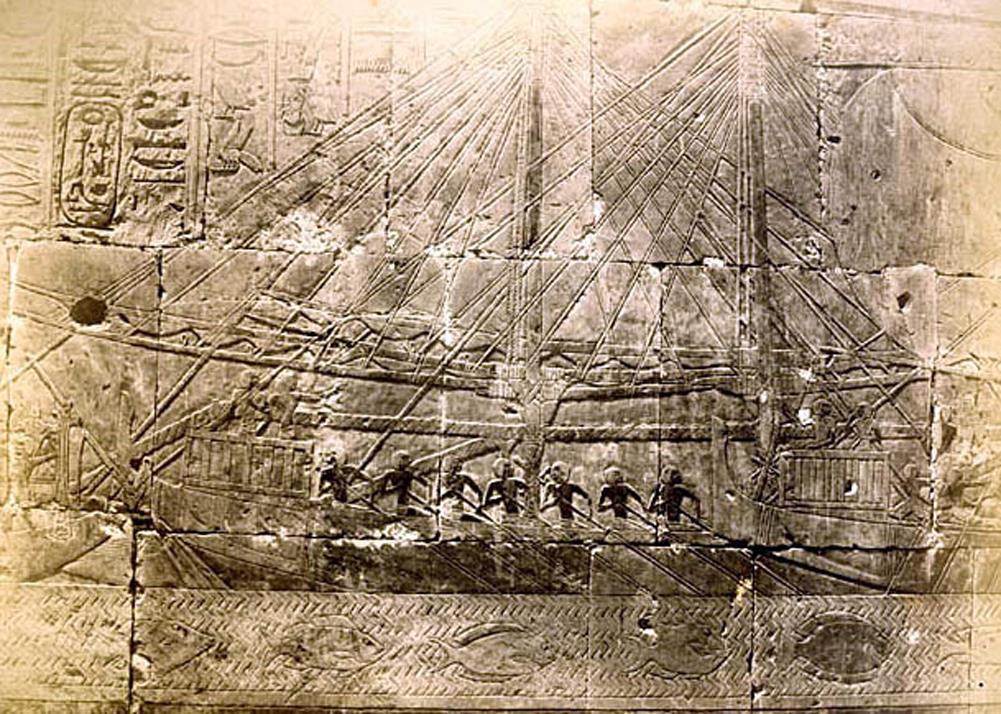History of Harnessing Wind Power
Magdi Ragheb, University of Illinois at Urbana-Champaign, Urbana, IL, United States Email: [email protected]
Abstract
The history of wind power evolution from antiquity to contemporary time is presented. From the use of sails to electrical utility-scale modern wind generators, wind power has been reengineered using modern materials and engineering knowledge. It is a fascinating field of study and captivates the interest of passionate creative, and romantic people. Its future success will depend on setting its footing on solid and realistic science and engineering and away from unrealistic dreams of perpetual motion machines and unbiased romanticism. As wind machines depend on the wind as an energy source and as wind is intermittent, unreliable, unsteady, and unpredictable, it requires the development of innovative energy storage technologies.
The advantage of the wind as a source of energy is that it is not just renewable, but infinite in magnitude originating in the Sun’s fusion energy that is trapped in the Earth’s atmosphere. As fossil fuels are experiencing localized as well as global peaking in their production and concerns about pollution and the release of greenhouse gases, wind machines are reclaiming, with new materials, electronic controls and advanced technology, an important share of the energy production realm. The renewable sources of energy are characterized by the use of a large labor supply providing job opportunities in highly populated economies. Their implementation is rapid: it takes about 2 years in the United States for the production of wind turbines, the implementation and the establishment of a wind park or farm as they only require local regulations, whereas nuclear power stations require 10 years or more because they are bound by lengthy federal regulations. The world is embarking on a third industrial revolution: the Low Carbon Age; and wind power is being reinvented to help fill the emergent need.
Keywords
Wind; wind power; windmill; wind turbine; wind history; windmills evolution
There is nothing new under the sun but there are lots of old things we do not know.
Ambrose Bierce, USA journalist, satirist
7.1 Introduction
President Abraham Lincoln, in the “Discoveries and Inventions” 1860 lecture, New York Times, November 22, 1936, is quoted as:
Of all the forces of nature, I should think the wind contains the largest amount of motive power … Take any given space of the Earth’s surface, for instance, Illinois, and all the power exerted by all the men, beasts, running water and steam over and upon it shall not equal the 100th part of what is exerted by the blowing of the wind over and upon the same place. And yet it has not, so far in the world’s history, become properly valued as motive power. It is applied extensively and advantageously to sail vessels in navigation. Add to this a few windmills and pumps and you have about all. As yet the wind is an untamed, unharnessed force, and quite possibly one of the greatest discoveries hereafter to be made will be the taming and harnessing of it.
Wind power has been used since early history by mariners for sailing boats on rivers and lakes and then ships at sea. Since the early recorded history it has been used by successive cultures and civilizations. It is a fascinating field of study and captivates the interest of passionate creative and romantic people. Its future success depends on setting its footing on solid and realistic science, engineering and economics; and avoiding unrealistic dreams of perpetual motion machines and unrealistic romanticism. Compared with modern machines powered by fossil fuels, wind machines depend on the wind as a fuel. Unfortunately, the wind is intermittent, unreliable, unsteady, and unpredictable and in some places on Earth it does not even blow at all. Yet, the advantage of the wind as a source of energy is that it is not just renewable, but infinite in magnitude originating in the Sun’s fusion energy that is trapped in the Earth’s atmosphere.
Windmills and water-driven mills were the only power generators for over 1200 years predating the 18th century’s Industrial Revolution. They existed in antiquity in Egypt, Persia, Mesopotamia, and China. In the 7th century BC, king Hammurabi of Babylon implemented a plan to irrigate the fertile plains of the Euphrates and Tigris Rivers using vertical-axis wind machines [1].
Wind energy conversion has been reinvented many times in human history and is undergoing a new process of reengineering as the leading mechanically based renewable energy source. It is challenging the conventional energy sources into becoming a viable alternative to them. As fossil fuels are experiencing localized as well as global availability problems and peaking in their production and concerns about pollution and greenhouse-gas emissions, wind machines and generators are reclaiming with; new materials, electronic controls and advanced technology, an important share of the energy production field (Fig. 7.1).
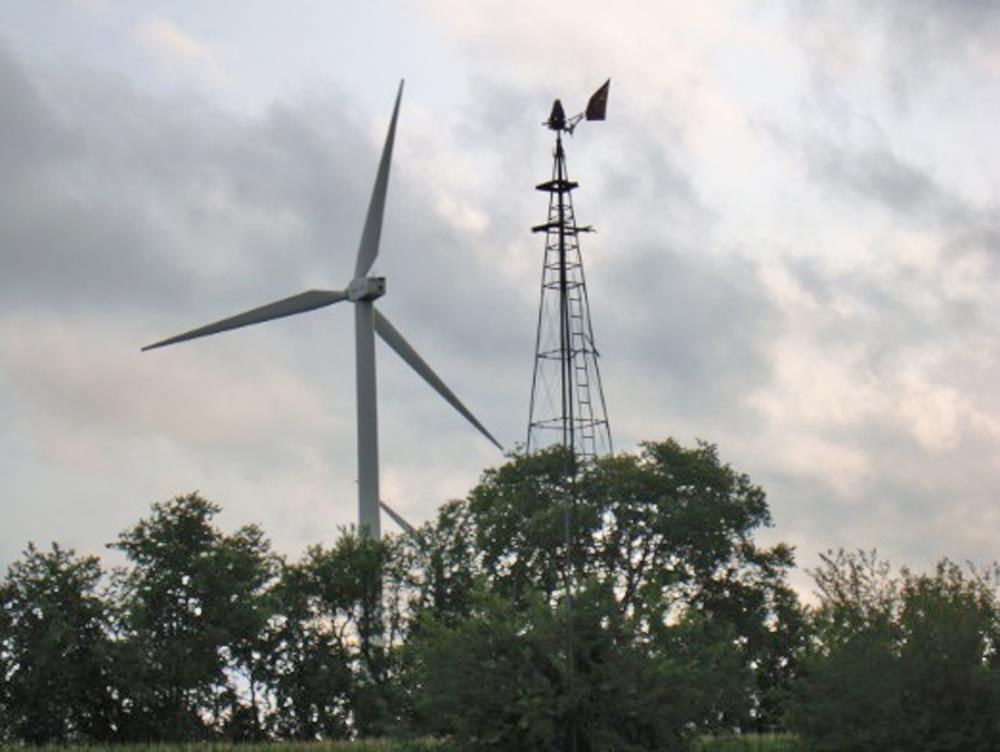
The word “windmill” primarily refers to a wind-powered machine that grinds or mills grain such as wheat or corn and turns it into flour for bread making. This has been the most common function in addition to numerous other applications such as grinding of spices, lumber sawing, mines ventilation, iron and copper foundries power, gun-powder manufacturing, oil extraction from oil seeds, nuts and grains, converting old rags into paper, grinding colored powders into dyes, manufacturing snuff tobacco and water pumping in Europe in the pre-Industrial Revolution era, and even lopping bee hives into towns under siege during warfare.
Holland has used windmills since AD 1350 to drain marshes and shallow lakes and turning them into productive agricultural land. They were coupled to an Archimedean screw, Egyptian noria, or Persian water wheel; all of them are early pump concepts which could elevate water to a height of 5 m. The noria’s etymology comes from the Arabic: “Al Naoura” which literally means: “The wailing;” so-called because of the wailing sound it generates as it rotates. The “noria,” is basically a water wheel that lifts water into an aqueduct carrying water to cities and fields using the flow energy of a water stream, similar to the modern hydraulic ram. It has a function similar to the chain pumps of which the “saqiya,” literally “irrigator” in Arabic, which dates back to Babylonian (700 BC) and Pharaonic (4000 BC) times, is an example. Noria machines were in widespread use in the premedieval Islamic civilization before their evolution into the European windmills, and specimens are still in operation in some parts of the world today. Their introduction may have originated from Spain where Ibn Bassal (AD 1038–75) of Al Andalus (Andalusia) pioneered the use of a flywheel mechanism in the noria and saqiya to smooth out the delivery of power from the driving device to the driven machine [1].
Windmills were replaced by steam and internal combustion engines using fossil fuels ranging from coal to oil and natural gas as well as hydroelectric and nuclear energy. Nowadays wind turbines are primarily used in electrical power generation. The terminology “wind generators” becomes a more appropriate designation. Wind power has evolved from impulse or drag-driven heavy systems to light aerodynamic systems. The latter is not a modern concept, as it has been known to the ancient sailors and mariners and was applied to the development of sail windmills.
7.2 Wind Machines in Antiquity
Out of respect of the wind capability of destructiveness in tornadoes, hurricanes, typhoons, and storms, legends arose that the winds were imprisoned underground within the Earth and were released at the whim of a beneficent or malevolent deity. In ancient Greece, the god Aeolus was the ruler of the winds. Many primitive people thought that the wind could be controlled by magic. Control over the wind resources was reserved to the Royals in some societies, and later to the clergy [1].
In early Christianity, it was thought that the wind was God breathing to punish or reward the Earthly mortals. Mariners for centuries had legends dealing with their fears and superstitions about the wind. As early as 4000 BC, ancient Egyptian pottery depicts ships with square sails using the prevailing northerly wind to sail up the Nile River from north to south against its current. During the ancient Egyptian Fifth Dynasty around 2500 BC, sailing ships advanced enough to go to sea and made trading trips along the East Coast of Africa to the land of Bunt. A relief on the walls of the Deir Al Bahari Queen Hatshepsut’s temple in Luxor, Egypt, shows the sailboats sent on a trading and exploration expedition around the East coast of Africa. They sailed through an ancient canal dug to connect the Nile River to the Red Sea (Fig. 7.2). By 150 BC an account by Hero of Alexandria, Egypt in his Spiritalia seu Pneumatica describes a pneumatic application of a four-bladed wheel driven by the wind moving the piston of an air pump to blow the pipes of a musical organ with compressed air. A prayer wheel was used in Asia around AD 400 whose scoops caught the wind and rotated on a vertical shaft.
7.3 Islamic Civilization Windmills
Around 200–100 BC windmills with woven reed sails were used in the Middle Eastern region for grinding grain. The first documented invention of a real windmill occurred in the year AD 644 during the rule of the second Islamic Khaliph: Omar Ibn Al Khattab. A subject of Persian heritage, who proposed to him that he is able to build one, was commissioned by the Khaliph Omar Ibn Al Khattab to build a grain mill rotated by the wind.
The next written account comes from two Islamic geographers who tell of windmills built in the sandy and windy province of Seistan in present day Iran around AD 947. The first application had to do with drifting sand dunes which could bury whole villages and cities. To control the sand drifts, the people of Seistan ingenuously enclosed the sand drift or dune in a structure of timber and thorny bushes higher than the dune. In the lower part, they opened a door for the wind to enter and blow away the upper levels of sand in a vortex or tornado carrying the sand to be deposited evenly on the surrounding fields [1].
The Islamic geographer Ali Al Massoudi writes about Seistan in AD 947that: “Wind turns mills which pump water from wells to irrigate the gardens. There is no place on Earth where people make more use of the wind.” Another Islamic scholar, Al Qazwini in AD 1283, describes how the people of Seistan used the wind to grind their wheat, as well as to control the drifting sand and to pump water. From that perspective, the region of Seistan can be considered as the birthplace of the eastern vertical-axis windmill in Islamic times (Fig. 7.3).

The Syrian cosmographer Al Damashqi (The Damascan) in AD 1300 describes in detail these vertical-axis windmills. They were erected in high places on top of hills, a mosque minaret or a tower in a castle. They were built as two-storied structures. The mill that turned and ground the grain into flour was at the upper story. The lower part contained the mill that was rotated by the blowing wind. The wheel turned one of two millstones in the upper section. Four slits existed in the walls of the first story with the outer part wider than the inner part. This formed ducts through which the wind blew from any direction. The ducted wind hit a reel with 6–12 cloth-covered arms rotating it. The reel moved the millstone that ground the grain. Other vertical windmills were used around the same time period in Afghanistan. They were driven by the prevalent north wind. A series of shutters and shields controlled the wind inlet [1].
Used originally in Persia and Afghanistan, windmills spread throughout the Islamic World and the Far East grinding grain and pumping water. They were adapted to crushing sugarcane for the manufacture of molasses and the extraction of sugar in Egypt. Centuries later, in the West Indies and the Caribbean Region, the West Indians hired Egyptian millwrights to establish the first sugar plantations. As Genghis Khan invaded Persia in the 12th century, the millwrights were induced to travel to China where bamboo horizontal mills with sails of matting adapted from Chinese sailing boats designs became common in the open fields. Superstition apparently suppresses their use today.
7.4 Medieval European Windmills
The concept of the windmill first spread to Europe through the Islamic culture established in Morocco, at that time period referred to as Andalusia, to contemporary Portugal and Spain, by traders and merchants (Fig. 7.4). Another entry was through the trade routes through Russia and Scandinavia. A third route is attributed to the returning crusaders to Europe from the Middle East. A fourth way was through the Islamic Sicily into Italy.
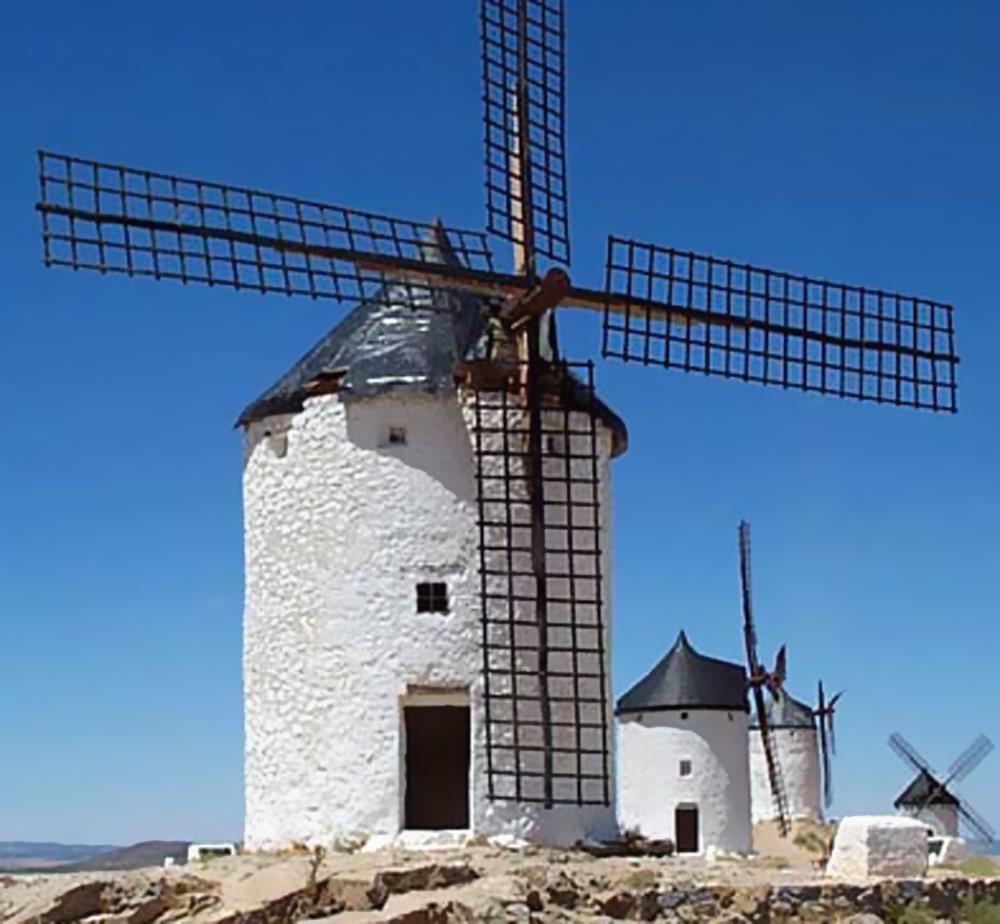
The historian Mabillon in AD 1105 writes that a convent in France was allowed to construct watermills and windmills. Windmills according to him were becoming common in Italy in the 12th century. Questions aroused about whether the tithes for them belonged to the clergy. The controversy was decided in favor of the Church by Pope Celestine III. Mabillon recounts a story about an abbey in Northamptonshire, England in AD 1143 that was in a wooded area which was denuded over a period of 189 years: “That in the whole neighborhood there was no house, wind or water mill built for which timber was not taken from this wood.” As wood was depleted for windmills construction, coal was used as a replacement energy source as a harbinger of the steam engine and the Industrial Revolution [1].
The first record of a windmill built in England was in Bury St. Edmunds in 1191. It was built in defiance of the then-vested authority and later destroyed by the Abbot. By the 14th century, the British monarchs watched the victories and defeats of their battling armies from the safety and high ground of the top of windmills scattered on the hills. A windmill was erected in Cologne, Germany in AD 1222. A windmill appeared in Siena Italy in AD 1237. Count Floris V in Holland granted the burghers of Haarlem the right to pay 6 shillings in tax for a windmill and 3 shillings for a horse mill in 1274.
In the 12–15th centuries the construction of windmills spread throughout central Europe all the way to Scandinavia reaching Finland in AD 1400. Windmills became the prime power movers all over Europe for grinding grain, pumping water, paper making, pressing oil from oil seeds, and sawing wood for ships and homes construction. The Dutch drainage mill was developed in Holland maintaining the land reclaimed from the sea, marshes, or shallow lakes. The Cistercian monks in France had introduced such a type of windmill to drain the lakes of their region. Peat was being mined for fuel needed by emerging cities, and this formed shallow lakes which grew in size over time and required systematic drainage by the 1300s. The first Dutch marsh mills were started by 1400. By 1600 there were 2000 of them operating to drain 0.8×106 ha (2 million acres) of land in Holland.
7.5 Aegean and Mediterranean Windmills
The windmills on the island of Crete, the Aegean Islands as well as Portugal and Spain were tower mills. The post mill which evolved into the tower mill was never observed in the Aegean area. Jib or triangular sails were typically used in the Iberian Peninsula and the Mediterranean. Their similarity to sailing ships is noticeable. They used 6–12 triangular cloth sails that were put up or down through roller reefing or by rolling them around the sail support. They were situated at the center of the mill or sheeted at mid-ship (Fig. 7.5).
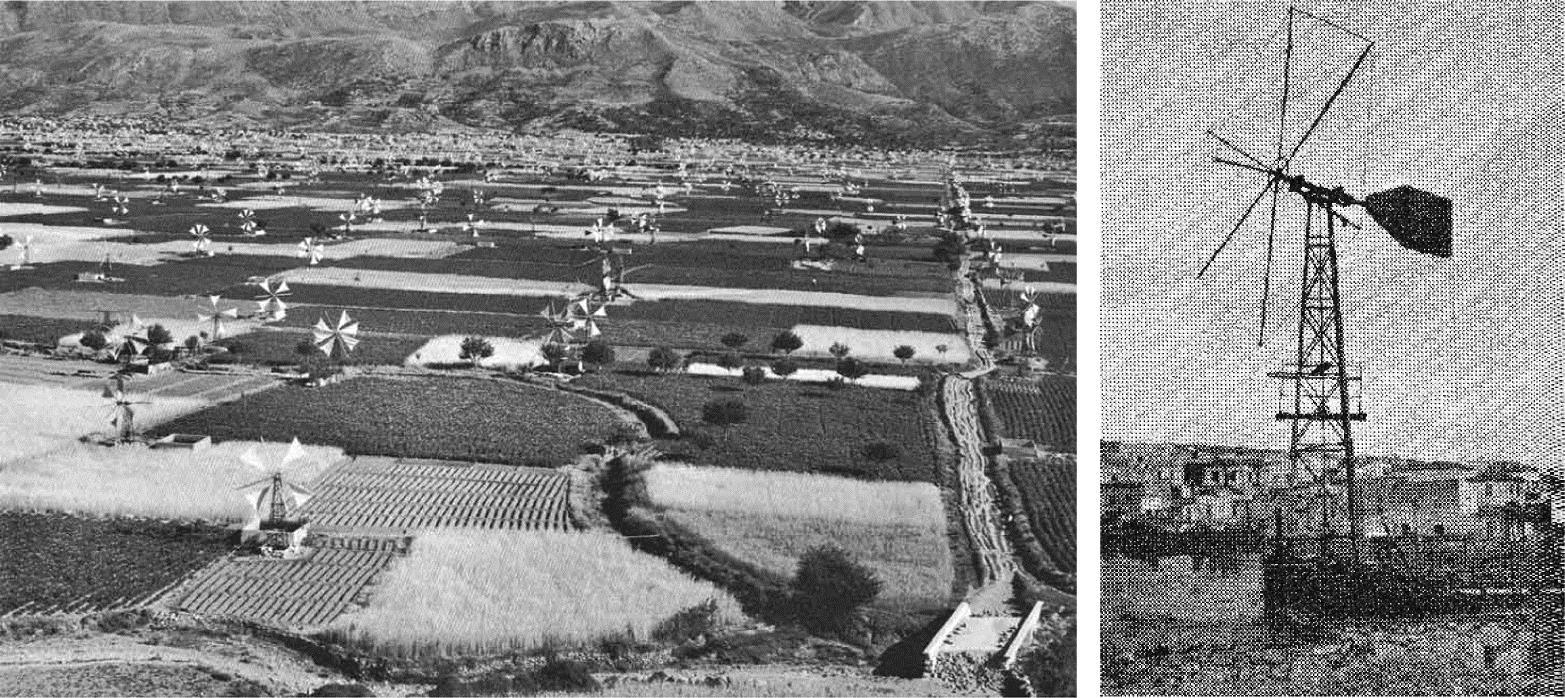
The Aegean Islands windmills were small compared with the European windmills with a size of 4–12 m in diameter. The Dutch polder or scoop windmill measured about 29 m in diameter. They were placed four to twelve in a row. Being efficient and well suited to the local conditions, they survived long after their use as wind power usage declined elsewhere.
Polders are low-lying tracts of land-forming hydrological entities that are surrounded by dikes or embankments. These are usually land reclaimed from a body of water such as an ocean shore or a shallow lake. They exist usually below sea level at river deltas, coastal areas, and fenlands and require constant drainage by opening sluices at low tide, by windmills in the past and pumps at present. The city of New Orleans in the United States is considered a polder area, seriously affected by flooding from hurricanes.
The earliest windmill structures were developed in the Middle East at the time of the Islamic Civilization and spread along the Mediterranean coast and in Persia around AD 500–900. Windmills technology was partly transferred to Medieval Europe by the returning crusaders in the 12th century. It developed there as the horizontal-axis design with tall structures on which the sails turned at a right angle to the ground.
Vertical-axis windmills are still being built in different parts of the world by enterprising farmers for irrigation and drainage purposes. A conventional aerodynamic sail and a Chinese impulse sail vertical-axis designs were built and used. An early description of a Chinese windmill was around AD 1219 by Yeh Lu Chu Tshai, a Chinese statesperson. Vertical-axis windmills using drag or impulse rather than cloth sails were built in Nebraska, United States around 1898 (Fig. 7.6).

Vertical-axis windmills have the advantage of a simple design consisting of six or more sails that are set upright upon horizontal arms resting on a tower or in the open, and which are attached to a vertical shaft positioned at the center. The sails are set in a fixed position that is oblique to the direction in which the wind will hit them. Their operation is independent of the direction from which the wind blows. Disadvantage of the vertical-axis design is that it may not be self-starting, and only one or two of the sails would catch the wind at any given time. The part of the sail catching the wind must then expend energy moving the dead weight of the part that is not catching it unless a shield configuration is adopted. Thus vertical-axis windmills are considered as less efficient than horizontal-axis windmills where the force of the blowing wind is evenly distributed on all sails [1].
7.6 Dutch and European Windmills
European windmills were custom designed and built with the particular site and wind conditions taken into consideration. They were of primary importance in the life of rural Europe, grinding grain for flour and pumping water, so that they were installed before other structures were erected at European villages. Being erected on high ground to catch the wind from all directions, they were major landmarks seen from long distances by travelers.
The horizontal-axis machines were considered to possess a higher efficiency than the vertical-axis types; hence they were widely adopted in Europe. The villagers personalized them and gave them individual names, much like boats today. The miller, doubling as a wind wright, commanded high authority, wealth, power, and respect in the village hierarchy. He usually charged the farmers a fraction of the grain being milled for his service. This was supplemented by the flour dust accumulated on different parts of the windmill that he collected as a bonus. Being the richest man in town made him prominent politically. The miller’s profession was a hazardous one particularly under stormy wind conditions. It required great skill and bodily strength climbing up the structure unfurling the sails for wind operation, or furling them to prevent the windmill arms from running away, damaging or destroying the windmill structure under wind gale conditions. With wooden windmills, the danger of fire was prominent through friction [1].
There evolved three types of European windmills (Fig. 7.7):
1. Post design: The post design refers to a massive upright post around which the entire body of the mill rotates in the direction of the blowing wind and was first described in AD 1270. The body of the mill supported the sails and the equipment. These designs were constructed out of wood. They used wood cog and ring gears to transmit the rotor blades rotation to a horizontal grindstone.
2. Tower design: This is also often referred to as the Dutch Mill. It was developed in the 14–15th centuries starting around 1390. The tower mill was installed on top of a tower of several stories. The construction material is brick with a wooden roof. It differs from the post mill in that instead of the whole windmill rotating around a central post, only its top or cap rotated to position or yawed the rotor blades to catch the wind. It formed an integral system for grain grinding and storage as well as the living quarters of the wind wright or wind smith and his family on the first story. The windmill needed continuous undivided attention while it was running, particularly under stormy conditions where the wind wright had to furl the sail on the blades and brake the mill to a stop. A runaway windmill is a hazardous situation that if uncontrolled, would literally disintegrate the whole structure launching flying debris into neighboring structures; a hazard that exists in modern wind turbines. The post and the tower windmills had to be yawed manually to face the wind using a large wheeled lever at the back of the windmill. A lateral fan was added later to automate the yaw orientation of the mill into the prevailing wind direction.
3. Smock design: The smock design differs from the tower windmill in the construction materials used. The smock design has a stone base with a wooden upper section that is framed with weather boarding that is either tarred or painted. The name “smock” originates from the way these windmills’ appearance looks like the linen smocks worn at the time in Holland and Europe [1].

7.7 The American Windmill
This multiblade design appeared in Europe in the 17th century. Leupold Jacob from Leipzig in 1724 in a book: Journal of Hydraulic Arts, or in German: Schauplatz der Wasser Künste, introduced an eight-bladed self-regulating wind turbine that drove a single action piston water pump using a crankshaft and a tie rod. In an ingenious design, each blade was capable of pivoting around its own axis maintained by a spring system that is progressively extended in a high wind condition resulting in the rotor revolving in a gale no faster than in a moderate wind, avoiding the destructive situation of a runaway wind turbine (Fig. 7.8).

This design did not spread on the European continent, but rather on the American Great Plains. Starting in 1870, as a simple, economic, and a most successful design, it conquered the American continent and migrated back to Europe and the rest of the world where it was named: “The American Windmill.” The most common windmill in America was built in the 19th century as a vertical steel structure topped with a rotating multibladed drag or impulse propeller that caught the wind. Its rotational motion is converted into linear motion that pumped water and stored it in a water tank for irrigation, cattle drinking, and water supply to steam locomotives.
The American Windmills were simple in construction and standardized in design. They could be easily dismantled, moved to other locations for reassembly. Their maintenance was simple amounting to addition of lubrication oil to the geared components, with parts that are interchangeable and could be cannibalized from one machine to another. The standardization led to the spread of the American Windmills in many altered versions in the American West as well as all over the world.
Early on, wooden slats were nailed to rims with tail rudders for orientation toward the wind or yawing. Instead of using a rudder, some designs used weather vanes operating downwind from the tower. Speed control was provided by spring and weight mechanisms and by feathering the blades to reduce the thrust in high winds. Around 1870, galvanized steel blades replaced the wooden slats allowing high speed operation that needed a reduction gear box to operate the reciprocal water pump at its required low speed [1].
The Halladay design introduced in 1854 evolved into the Aermotor and Dempster designs that became operational in different parts of the world. Starting 1850, about 6 million small turbines of 750 W (one Imperial horsepower) power or less were installed in the United States, primarily for water pumping for cattle and farm needs. Larger windmills with rotor diameters of up to 18 m diameter provided water for the steam boilers of the locomotives of the western railroads. This is really how the “American West was won”: through the windmill and the steam locomotive.
7.8 Historical Developments
The earliest horizontal-axis windmills possessed short sails, which were made later longer and more efficient in catching the kinetic energy from the wind. As the sails were elongated, the axle or wind shaft on which they rotated had to be emplaced higher off the ground on the windmill structure or buck. Irrespective of their design, some common features exist in windmills. For horizontal-axis windmills:
1. A means of catching the wind through sails, arms, or rotor blades rotating around an axle.
2. A yaw mechanism to turn the sails, arms, or blades so that they face the wind. Otherwise, as the wind direction shifts, the windmill would stall.
3. A gear system and interlocking equipment transmitting the wind energy to the millstone, water pump, wood saw, or electrical generator that they are powering.
Vertical-axis windmills share the first and third features only since they catch the wind from all directions without the need to adjust them like in the case of the horizontal-axis windmills. The use of sails on the European windmills added and element of aerodynamic lift leading to higher rotor efficiency through its increased speed. The evolutionary perfection process took 500 years leading to windmills that have the components and features of the modern windmills.
Some windmills had aerodynamic brakes, spoilers, flaps, and leading edge airfoil sections that were precursors to the modern airplane wing. Features of modern airfoil rotor blades were incorporated through insight and trial and error: a nonlinear twist of the blades from their root to their tip, introducing a camber along the leading edge, emplacement of the blade spar at the quarter chord position at 25% of the way from the leading edge to the trailing edge, and designing the blade with its center of gravity at that same 1/4 chord position.
The simplest windmills sails are just cloth sails attached to the rotating arms or blades. Designs using multiple sails were used in the Mediterranean region such as at Alexandria, Egypt (Fig. 7.9). A design with small sails attached to multiple arms was used in Greece. With a small number of arms, large sails were used for a Portuguese, Spanish, and French windmills. Some were equipped with bells at the end of its rotating arms, generating an audible alarm for stray cattle or humans.
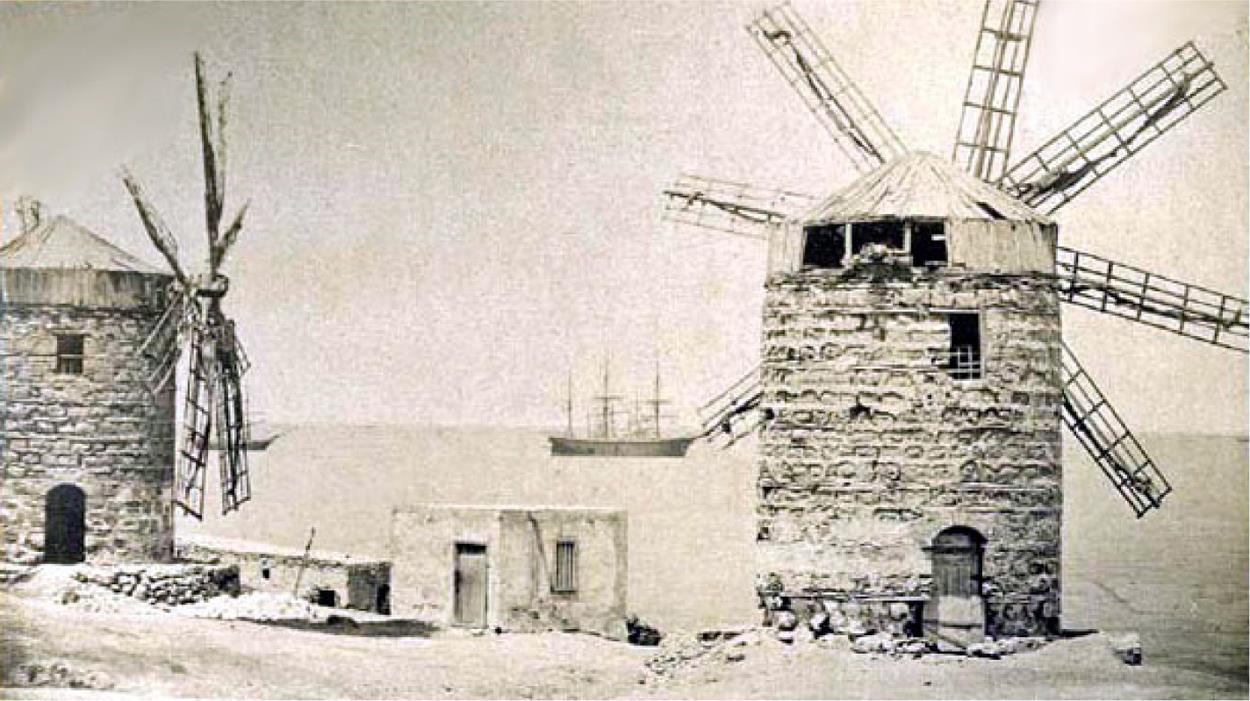
Better structural strength was achieved with wooden frames covered with cloth in what became known as common sails. Initially the cloth was only placed over the frames or entirely removed. Later, a method for reefing or furling the cloth was developed to control the sail area depending on the wind speed. The common sails were light in weight and powerful but they had to be stopped by the mill wright furling the sail. Stopping the mill by an additional brake was needed. In many situations the wind became stronger than the brake could handle. The mill then could run out of grain and its millstones would now run dry, generating a spark shower igniting fires. Runaway wind turbines could also lead to vibration that would disintegrate the windmill wooden parts. In freezing weather, the cloth could become wet and frozen.
The wind wright had to skillfully ride out a storm much like a sailing ship’s captain had to weather a storm at sea. One method to slow the sails in a high wind was to jam the grain into the millstones so that they act as a brake slowing down the sail rotation. A second method was to force the sails edge onto the wind. If the wind suddenly shifted, it could hit the windmill from behind with the sails and cause them to be blown off [1].
Combinations of wood and metal were used to prevent fires from friction of similar components. Many cloth sails lasted for as long as 40–50 years. Interestingly, the sails were built with a counterclockwise rotation, a tradition that endures today in most wind turbines, with rare exceptions.
Modern wind generators have evolved from a drag or impulse system into an airfoil system similar to airplane propellers and wings. Wood and glass epoxy, fiberglass, aluminum, and graphite composite materials are now used in their construction.
7.9 Windmills Applications
Barley- and rice-hulling windmills operated by hulling stones which were larger than the common millstones removing the thin outer cover of the grain kernel. They were grit stones with a few deep furrows with the grain flung out along them without being ground. Requiring heavier equipment and a stronger wind location than grinding mills, hulling mills were limited in number [1].
Different windmill applications required different specialized machinery. Oil mills pressed oil from oil seeds and nuts. Grinding mills ground spices. Saw mills sawed wood into planks for construction and ship building. Irrigation and drainage mills reclaimed the low lands of Holland or the Netherlands from the sea by drying out marches and shallow lakes. Polder drainage windmill designs used a scoop wheel or noria, and other designs used an Archimedean screw or “tambour.”
7.10 Discussion
At the beginning of the 20th century, the first modern windmills driving electrical generators were introduced in France by Darrieus and then spread worldwide. The steam engine and then the internal combustion engine replaced sails on ships and mills. Both were more efficient than windmills using fossil fuels as a source of energy rather than the wind [1].
It is recognized that the renewable sources of energy are characterized by the use of a large labor supply providing job opportunities in high-population economies. Their implementation is rapid: it takes about 2 years in the United States for the implementation and production from wind parks projects since they only require local regulations, whereas other conventional energy sources such as coal and nuclear power stations require 10 years or more because they are bound by lengthy federal regulations [2–7].
A symbiotic coupling of wind technologies with other energy sources exists through sharing access to the electrical grid system. The two units 2309 MWe Boiling Water Reactors LaSalle nuclear power plant near Marseilles, Illinois, United States operated by Exelon Nuclear Corporation and the Grand Ridge Wind Farm operated by Invenergy LLC in the adjacent farmland near Ransom in Illinois, United States are jointly sited and connected to the same electrical grid system. The nuclear reactor and the wind turbines are both manufactured by the General Electric (GE) Company. The GE 1.5 MW SLE wind turbines have a hub height of 80 m and are net recipients of about 5 kW of electrical power from the grid on a standby basis, but then become net exporters of electricity into the electrical grid under favorable wind conditions (Fig. 7.10).
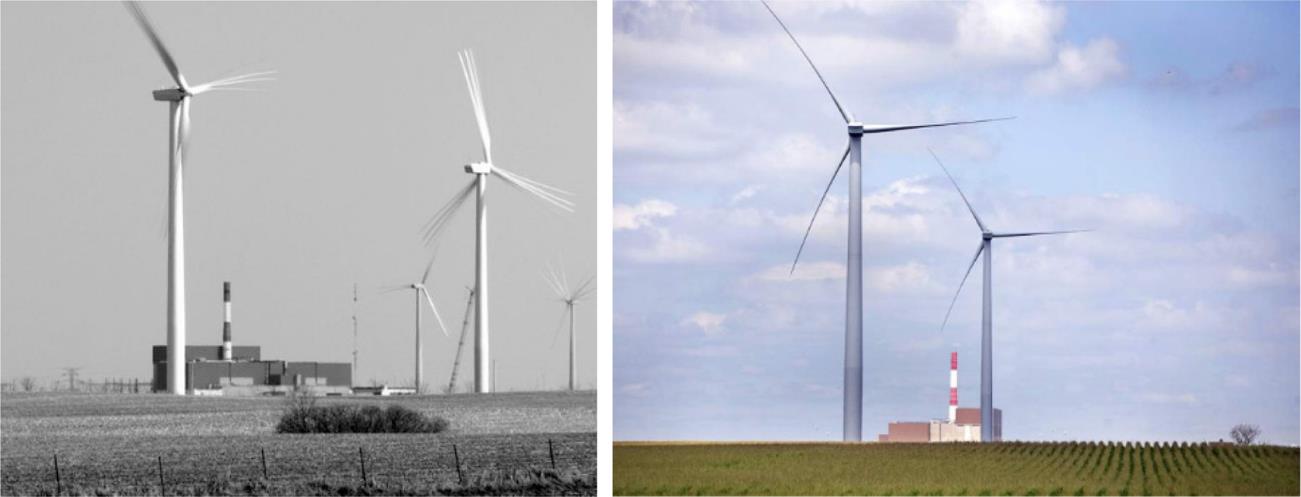
The world is embarking on a third industrial revolution: the Low Carbon Age; and wind power is being reinvented to help fill the need.

